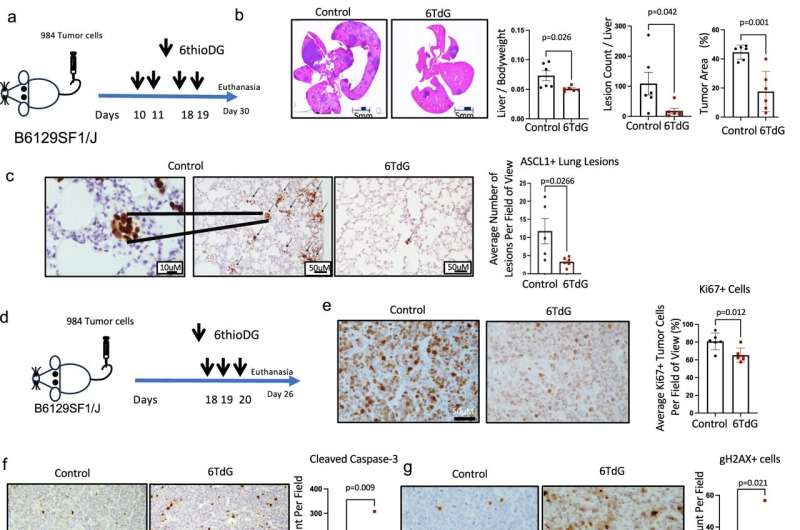This article has been reviewed according to Science X's editorial process and policies. Editors have highlighted the following attributes while ensuring the content's credibility:
fact-checked
trusted source
proofread
Lung cancer treatment shows promise in tumor models

A molecule has demonstrated its ability to kill tumor cells and incite an immune response in preclinical models of small cell lung cancer (SCLC), according to UT Southwestern Medical Center researchers. The findings, published in Nature Communications, could lead to more successful treatments for SCLC, one of the leading causes of cancer-related deaths in the U.S.
"We have a really exciting new drug that could target a disease that's very difficult to treat," said Esra A. Akbay, Ph.D., Assistant Professor of Pathology and a member of the Development and Cancer Research Program of the Harold C. Simmons Comprehensive Cancer Center at UT Southwestern. "This research marks a crucial step toward potentially reshaping the standard of care for small cell lung cancer patients."
With more than 32,000 new cases expected to be diagnosed in the U.S. in 2024, SCLC is a particularly lethal cancer with limited effective treatment options. While SCLC tumors may initially respond to therapeutics, they're highly metastatic and tend to develop treatment resistance. They're also successful at concealing themselves from the body's immune system.
Scientists believe that treatment resistance is tied, in part, to the abundance of cancer-initiating cells (CICs) in these tumors that, in turn, increase the total number of SCLC cells and drive their migration and spread to other organs. CICs produce telomerase, an enzyme that preserves telomeres, which are the protective caps at the end of DNA sequences. Normal cells die or senesce as their telomeres shorten over time. In cancer cells, however, the telomerase enzyme helps cancer cells maintain their telomeres, live longer, and metastasize.
Dr. Akbay and her team devised a series of tests using the telomere-targeting molecule 6-thio-2'-deoxyguanosine (6-thio-dG). After entering the bloodstream, 6-thio-dG is rapidly incorporated into tumor cells where it damages telomeres and causes cell death while at the same time sparing healthy cells.
"It's difficult to devise treatments that affect cancer cell DNA because most of the time they're also toxic to bone marrow cells, which produce immune and blood cells," Dr. Akbay explained. "But 6-thio-dG is nontoxic to healthy cells in therapeutic doses."
Dr. Akbay's team tested the efficacy of 6-thio-dG both in vitro and in mouse models and found that it inhibits the growth of SCLC cells, even those resistant to chemotherapy.
The drug also had positive effects on the tumor immune environment. Researchers found that 6-thio-dG makes SCLC in mice more visible to the immune system. It increased recruitment of T cells and natural killer cells and decreased the presence of myeloid cells that can promote tumor growth. In mice with intact immune systems, they found that 6-thio-dG can sensitize SCLC cells to radiation treatment.
More information: Buse Eglenen-Polat et al, A telomere-targeting drug depletes cancer initiating cells and promotes anti-tumor immunity in small cell lung cancer, Nature Communications (2024). DOI: 10.1038/s41467-024-44861-8

















